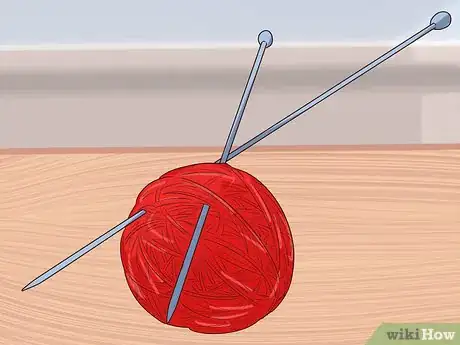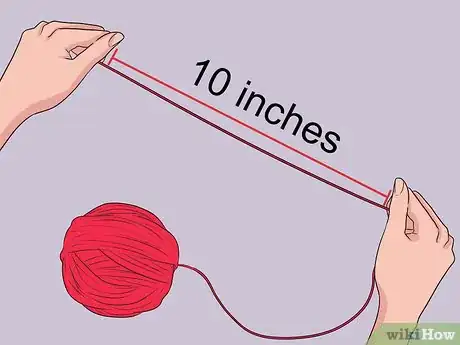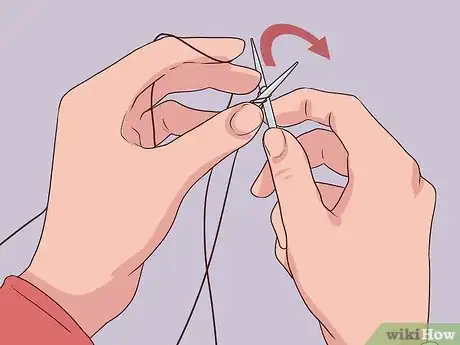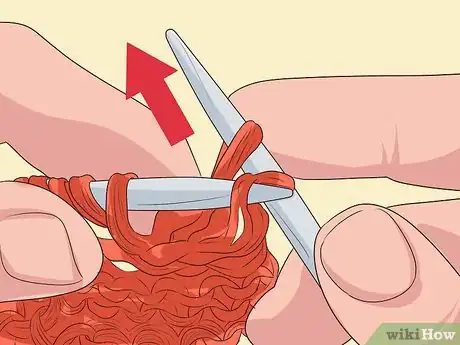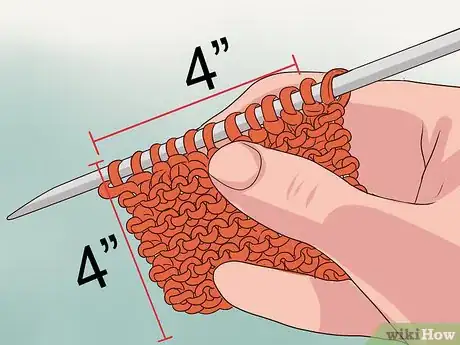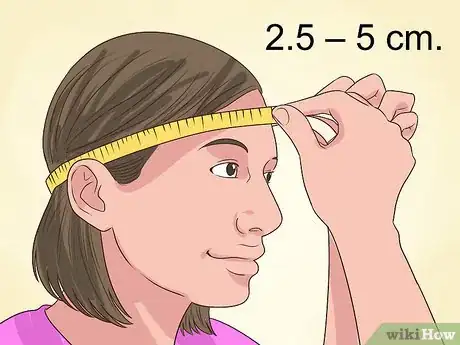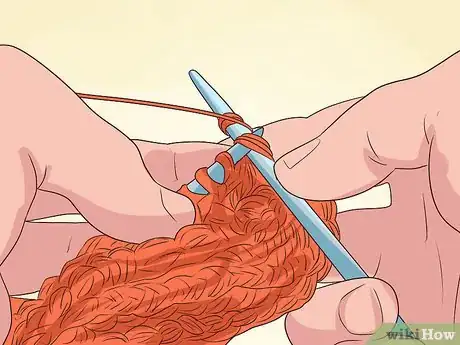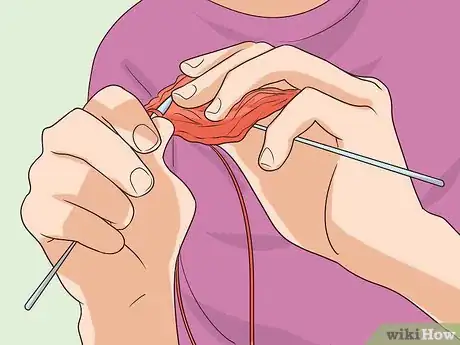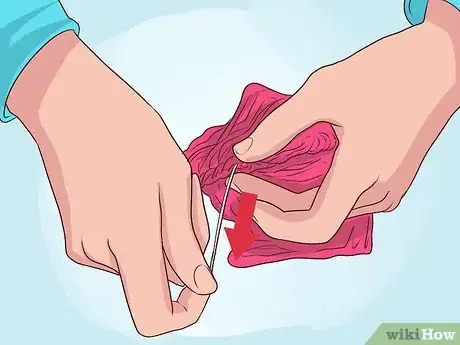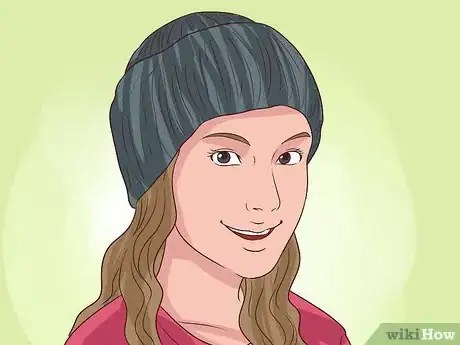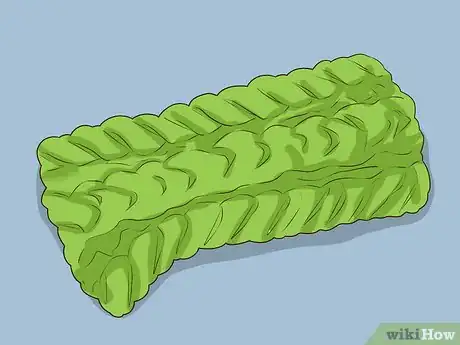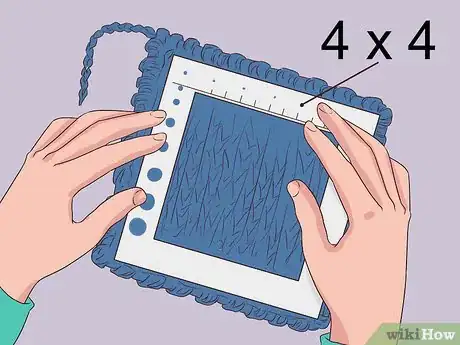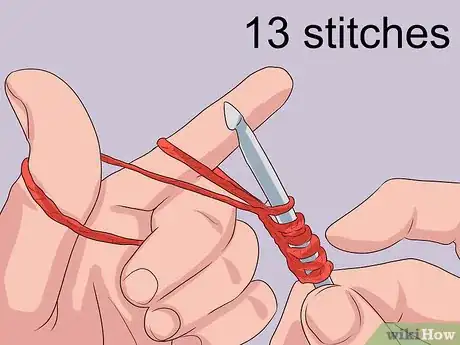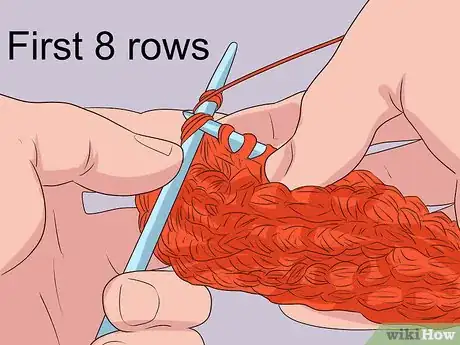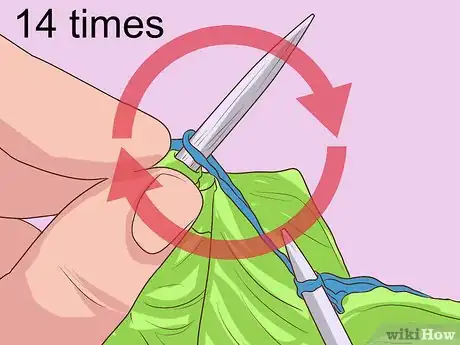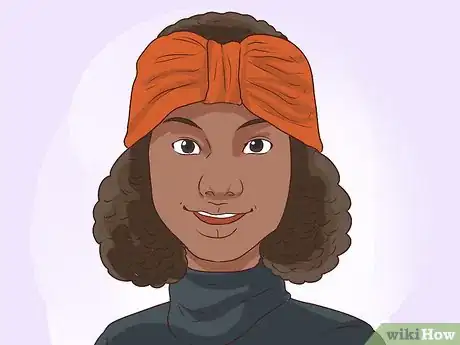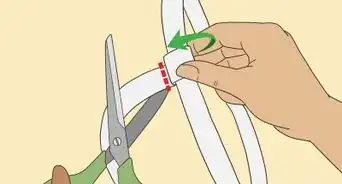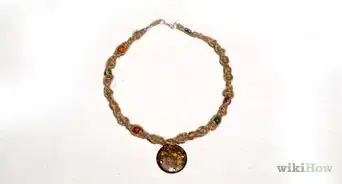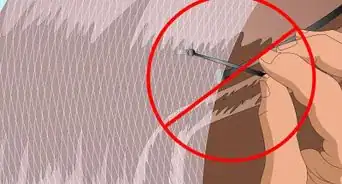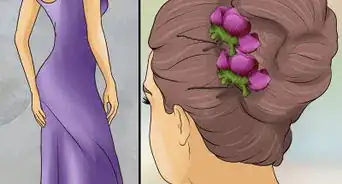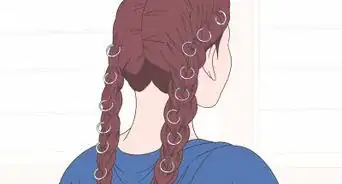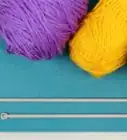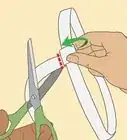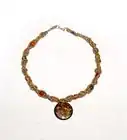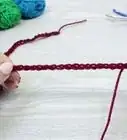This article was co-authored by Jen Webber. Jen Webber is a Knitting Specialist and the Manager of The Quarter Stitch, a crafting store based in the French Quarter of New Orleans, Louisiana. With over 17 years of knitting and crafting experience, Jen helps educate customers and the public on best knitting practices for their DIY projects.
This article has been viewed 524,914 times.
A knitted headband will keep your ears warm when the air outside is at a temperature less than comfortable. You can also adapt these instructions to make a lighter, thinner headband that can be worn in warm weather to hold your hair off your face. Get yourself some yarn and a pair of knitting needles, and you'll save a lot of money. Who knows, maybe you'll discover a new hobby in the process!
Things You Should Know
- If you're a beginner, you'll need to learn the basics first: casting on, knitting either garter or cabbage stitches, and casting off, and buy yarn.
- To make a beginner's headband, measure your head using a gauge swatch, knit the amount of rows necessary to create a fitted headband, and finally, sew the bound-off edge to the cast-on edge.
- For a more complicated knit, make a headband that repeats an 8 row pattern and uses a knit stitch, purl stitch, and slip stitch.
Steps
Beginner Headband
-
1Gather your materials. You will need needles in size 8, 9 or 10 (US size) and a worsted weight (normal) yarn in a color you like. Gather these materials to begin your project.
-
2Learn how to cast on. Casting on is the process of beginning your first row of stitches, to which all the other stitches will be attached. The backwards loop cast on is as easy cast on for beginners to learn.
- Pull ten inches from your ball and make a loop in the yarn. Bring the long end through the loop and then pick up the yarn that is lying across the inside of the loop. Pull the loop while holding both ends of the rest of the thread. Slip a needle through the loop and tighten so that it is snug on the needle. Holding the needle with your right hand, drape the side of the yarn still attached to your yarn ball behind your left hand and around your palm. Bring the needle under the yarn across your palm and pull out your hand, leaving a loop formed around your knitting needle. Pull the loop tight and you have completed your first cast on stitch. Continue with the next stitch by wrapping the yarn behind your hand and around your palm once more until you have the desired number of stitches.
Advertisement -
3Learn how to knit stitches. For this project, either the garter stitch or cabbage stitch are recommended. The garter stitch in particular is a useful stitch that many beginners learn and will produce a sturdy, flexible piece of knitting.[1]
- To complete the garter stitch, hold your needle with the cast on stitch in your left hand and your other needle in your right hand. Insert the right needle into the first loop between the topmost stitches on the left needle so that the right needle crosses beneath the left needle. The yarn should lie to the back of your needles. Wrap the end yarn around the tip of the needle counterclockwise and hold it with your right index finger. Gently pull the tip of the right needle back through the first loop, keeping the yarn you looped around on the needle. Slowly pull the right needle all the way through and bring it up so that it is close and on top of the left needle. Be careful not to pull too hard so you don’t pull it out. Move the right needle upwards so that only the first loop on the left needle slides off over the top. Continue the rest of the stitches by inserting the right needle into the next loop on the left needle. Once all the loops are on the right needle you have finished your row. Switch the needles into the opposite hands and repeat for the next row.
-
4Learn to cast off. Casting off is the process of making the last row of stitches for your project. This last row must finish the stitches so that they cannot unravel later on. Casting off is an essential technique when learning to knit.
- When you get to the last row, knit the first two stitches onto your right needle. Push the left needle into the first stitch that you made on the right needle (the bottom stitch). Lift the first stitch over the second stitch (by moving it upwards) so that it is no longer attached to either needle. Knit another stitch from the left needle to the right needle and complete the same process (insert the left needle in between the stitches and then lift the bottom stitch over the top stitch). Continue until there are no stitches on the left needle and just one stitch on the right stitch. Remove your needle, cut the yarn ball away and pull the loose end through the loop and tighten to tie off.
-
5Make a gauge swatch. This swatch will be used to determine how many stitches to use for your headband and can also be good practice if you are a beginner. Cast on and knit about a 4" x 4" sample square, and measure how many stitches are in each inch, and how many rows, with the yarn you've picked. Write down that information.
- You will need this gauge swatch to determine the number of stitches for your final headband to be the width you would like.
-
6Cast on the number of stitches you'd need for the final piece to be 2.5" (6.4 cm) wide. (If you were getting 10 stitches per inch, you'd cast on 25, for example.) In this example, it'll be 16 stitches for size 8 to 10 needles.
- You can make a headband that is a bit wider or skinnier if you choose.
- Good beginner cast on methods include the long tail cast on and backwards loop cast on.
-
7Measure your head to determine how long your headband should be. Heads vary in size, so measure your own, and take off one to two inches (2.5-5 cm) for the stretchiness of the stitch. Again you should use the number of stitches you have calculated using your gauge swatch minus an inch or two (2.5-5 cm).
-
8Knit the rows the length of the headband. Because you'll want your headband to have some stretchiness, knit in a garter or cabbage stitch. In this example, cabbage stitch is used.
-
9Continue knitting until the piece is as long as you would like your headband to be. You can test the length by wrapping it around your head. Remember that it must be tight enough to stay on your head without falling down but loose enough to fit onto your head.[2]
-
10Cast off your stitches. Finish knitting the headband by casting off at the end. This prevents the knitting from unraveling later.
-
11Sew the bound-off edge to the cast-on edge. Using a piece of yarn and a blunt needle sew the two edges of your headband together. Line the edges up next to each other. Then, starting at one end push the needle through both layers and around the edge back through the same hole. Then move to the next stitch and push the needle through. Bring the needle around the edges and push through the next stitch along the edge. Continue until you reach the other edge of the pieces and have knitted the edges completely together.
- For added flair, twist the headband once before sewing the edges together. The twist will make the headband more comfortable at the back of your head, so your hair can fall normally.
-
12Try the headband on. The headband should now be completed and you can try it on to make sure it fits correctly. Enjoy wearing your headband and keeping your ears warm!
Intermediate Headband
-
1Try this headband for a more difficult pattern for intermediate knitters. This headband adds a cable knit pattern and the project is perfect for learning to knit a cable knit. This pattern also does not use that much yarn and is very pretty.
- You will need to know how to perform the knit stitch, the purl stitch and the slip stitch to be able to complete this headband.
- You will also need to know how to cast on and cast off your stitches.
-
2Gather your materials. You will need size 10.5 knitting needles and one ball of yarn with a yardage of about 87 yards/100 grams (3.5 oz) in a color of your choice. These materials will be used in your project.
-
3Make a gauge swatch. Cast on and knit about a 4" x 4" sample square, and measure how many stitches are in each inch, and how many rows, with the yarn you've picked. Write down that information to help you determine the number of stitches for your final headband.
- If you do not wish to make a swatch then you can simply knit the first couple of rows and see if it looks long enough.
-
4Cast on about 13 stitches. Usually you will use 13 stitches to create your headband. If you use a different number of stitches then you will have to readjust your headband rows to suit. You can use whichever cast on method your prefer for this project.
- Good beginner cast on methods include the long tail cast on and backwards loop cast on.
-
5Knit the first eight rows. This headband entails a repeating pattern every eight rows. The eight rows are each different to create one section of the cable pattern. You will use the knit stitch, the purl stitch and slip stitches to create these eight rows. You will also need a cable needle for these eight stitches.
- In row one knit thirteen stitches.
- In row two knit two stitches, purl nine stitches and then knit two stitches.
- In row three knit two stitches, slip stitch the next three stitches to the cable needle and hold in front, knit three stitches, knit three stitches from the cable needle and then knit five stitches.
- In row four knit two stitches, purl nine stitches and knit two stitches.
- In row five knit thirteen stitches.
- In row six knit two stitches, purl nine stitches and knit two stitches.
- In row seven knit five stitches, slip stitch the next three stitches to the cable needle and hold it in back, knit three stitches, knit three stitches from the cable needle and knit two stitches.
- In row eight knit two stitches, purl nine stitches and then knit two stitches.
-
6Repeat the eight rows 14 times. Repeat this eight row pattern 14 times or until the headband is the correct length. Remember it will stretch so you will want it to be tight enough to stay on your head.
-
7Cast off at the end of the last row. Cast off your last row to finish the end of the headband and prevent it from unraveling.
-
8Sew the bound-off edge to the cast-on edge. Using a piece of yarn and a blunt needle sew the two edges of your headband together. Line the edges up next to each other. Then, starting at one end push the needle through both layers and around the edge back through the same hole. Then move to the next stitch and push the needle through. Bring the needle around the edges and push through the next stitch along the edge. Continue until you reach the other edge of the pieces and have knitted the edges completely together.
-
9Try the headband on. The headband should now be completed and you can try it on to make sure it fits correctly. Enjoy wearing your headband and keeping your ears warm!
Expert Q&A
-
QuestionCan I wash or dry my headband?
 Jen WebberJen Webber is a Knitting Specialist and the Manager of The Quarter Stitch, a crafting store based in the French Quarter of New Orleans, Louisiana. With over 17 years of knitting and crafting experience, Jen helps educate customers and the public on best knitting practices for their DIY projects.
Jen WebberJen Webber is a Knitting Specialist and the Manager of The Quarter Stitch, a crafting store based in the French Quarter of New Orleans, Louisiana. With over 17 years of knitting and crafting experience, Jen helps educate customers and the public on best knitting practices for their DIY projects.
Knitting Specialist I wouldn't recommend putting anything you knit in a mechanical dryer, since that's going to be very hard on the fibers. It can even cause certain stitches to come undone. If you want to dry the headband, lay it flat and let it air dry.
I wouldn't recommend putting anything you knit in a mechanical dryer, since that's going to be very hard on the fibers. It can even cause certain stitches to come undone. If you want to dry the headband, lay it flat and let it air dry. -
QuestionWhat's better, acrylic yarn or wool?
 Jen WebberJen Webber is a Knitting Specialist and the Manager of The Quarter Stitch, a crafting store based in the French Quarter of New Orleans, Louisiana. With over 17 years of knitting and crafting experience, Jen helps educate customers and the public on best knitting practices for their DIY projects.
Jen WebberJen Webber is a Knitting Specialist and the Manager of The Quarter Stitch, a crafting store based in the French Quarter of New Orleans, Louisiana. With over 17 years of knitting and crafting experience, Jen helps educate customers and the public on best knitting practices for their DIY projects.
Knitting Specialist Acrylic is great because it's inexpensive, it's durable, and it holds up in a washing machine. Wool tends to be "fancier" but caring for wool clothing can be extremely complicated, and there are all kinds of considerations depending on the type of wool it is. If you're new to knitting, I'd go for acrylic.
Acrylic is great because it's inexpensive, it's durable, and it holds up in a washing machine. Wool tends to be "fancier" but caring for wool clothing can be extremely complicated, and there are all kinds of considerations depending on the type of wool it is. If you're new to knitting, I'd go for acrylic. -
QuestionWhat is garter stitch?
 LibraryMouseCommunity AnswerKnitting all rows.
LibraryMouseCommunity AnswerKnitting all rows.
Warnings
- Always watch your knitting to make sure it is the right length. Don't leave it to chance, or you'll end up with something that could probably be used as a belt for a four-year-old, or a crown for the amoeba queen. It takes only a few minutes, and really does help.⧼thumbs_response⧽
References
- ↑ Jen Webber. Knitting Specialist. Expert Interview. 4 August 2020.
- ↑ Jen Webber. Knitting Specialist. Expert Interview. 4 August 2020.
- Videos provided by ExpressionFiberArts
About This Article
To knit a headband, start by casting on the number of stitches you'd need to make your headband 2 1/2 inches wide. Then, knit the rows to your desired length using a garter or cabbage stitch, which will give your headband some stretchiness. Next, once your headband is long enough, cast off your stitches so they don't unravel. Finally, sew the bound-off edge to the cast-on edge to finish your headband. To learn how to cast on and cast off when you're knitting, scroll down!
